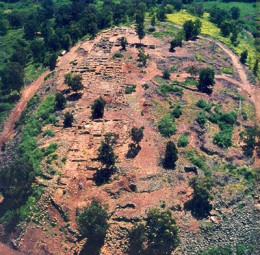The ancient village of Bethsaida frequently mentioned in the Gospels is believed to be located on the northern shore of the Sea of Galilee, but where precisely the abandoned city lies remains a fiercely-debated question among scholars. The post...

Where is Biblical Bethsaida? One contender is the site of et-Tell, a mile and a half north of the Sea of Galilee. Photo: Duby Tal and Moni Haramati, Albatross/Courtesy of Bethsaida Excavations.
The ancient village of Bethsaida is believed to be located on the northern shore of the Sea of Galilee, but where precisely the abandoned city lies remains a fiercely-debated question among scholars. Recent discoveries at the site of el-Araj have called into question the decades-old claim that et-Tell on the eastern shore of the Jordan River is this lost Biblical city.
Along with Jerusalem and Capernaum, Bethsaida is frequently mentioned in the Gospels. When Jesus was first calling his disciples, he traveled to Galilee and found there Philip, who is described as being of Bethsaida along with Peter and Andrew (John 1:43-44). The town—including its nearby shore—is identified as the location where Jesus performed some of his most indelible miracles. Here he led a blind man away from the village, restored his sight, and instructed the man not to reenter the town nor to tell anyone of the miracle he had performed (Mark 8:22–26). Bethsaida is also said to be the fishing village where Jesus fed the masses with just five loaves and two fish (Luke 9:10–17; Mark 6:30–44).
Discovering Biblical Bethsaida. Could a mosaic inscription at the site of El-Araj be the smoking gun archaeologists are looking for to determine the true location of biblical Bethsaida? Read More in this BHD article.
A consortium of schools headed by the University of Nebraska, Omaha, claim to be excavating Biblical Bethsaida at the site of et-Tell on the east bank of the Jordan River and have published their findings as the Bethsaida Excavations Project since 1991. For years, director Rami Arav has asserted that et-Tell’s archaeological remains sync up with historical accounts of the ancient village, including ancient Jewish historian Josephus’s report that under Philip the Tetrarch (one of Herod the Great’s sons), the town was improved, “… both by the number of inhabitants it contained, and its other grandeur” (Antiquities 18:2). In 30 C.E., Philip had renamed the city Julias after Livia-Julia, Roman emperor Augustus’s wife and mother of Tiberius, the reigning emperor at the time. Arav cites occupation and substantial growth of the town throughout the Roman period as evidence corroborating Josephus’s account.1

FREE ebook: The Galilee Jesus Knew
This claim, however, has not gone without criticism from other scholars. Most notably, Dr. Steven Notley, Professor of Biblical Studies at Nyack College, New York, has charged that et-Tell, a mile and a half from the Sea of Galilee, is too far from the body of water to be the Biblical fishing village.2
Since 2014, a team led by Mordechai Aviam, Dina Shalem, and Notley under the auspices of the Center for Holy Land Studies (CHLS) and Kinneret College has conducted survey and excavation at el-Araj, another proposed site for the location of Bethsaida. As reported in Haaretz, the 2016 excavations revealed evidence of early Roman occupation from the first through third centuries C.E., including a Roman-style bathhouse, mosaic fragments and a silver coin from 65–66 C.E. portraying Roman emperor Nero. The recent evidence shows that, despite assertions by Arav and others,3 there is significant Roman-era material culture at el-Araj.

Aerial view of the 2017 excavations at el-Araj, another candidate for Biblical Bethsaida. Photo: Zachary Wong.
These recent discoveries led the archaeologists at el-Araj to declare the site as Bethsaida, challenging the claim held for decades by et-Tell. The team suggests that the sea levels in antiquity would place el-Araj directly on the coast of the Sea of Galilee, an appropriate position for a fishing village compared to et-Tell. Arav disputes the interpretation of the recent discoveries, suggesting the conclusions are “extremely premature.”
As it stands, archaeologists from two separate sites now claim to be excavating Biblical Bethsaida, and both boast historical and archaeological evidence to support their case. Only further survey and excavation of the northern shores of the Galilee and discourse among the scholarly community can begin to elucidate this predicament of identity.
Samuel D. Pfister is the Collections Manager at the Badč Museum of Biblical Archaeology at the Pacific School of Religion, Berkeley, California.
Notes:
1. Rami Arav, “Bethsaida—A Response to Steven Notley,” Near Eastern Archaeology 74, no. 2 (June 2011), pp. 92–100.
2. Steven Notley, “Et-Tell Is Not Bethsaida,” Near Eastern Archaeology 70, no. 4 (December 2007), pp. 220–230; Steven Notley, “Reply to Arav,” Near Eastern Archaeology 74, no. 2 (June 2011), pp. 101–103.
3. Rami Arav, “A Response to Notley’s Reply,” Near Eastern Archaeology 74, no. 2 (June 2011), pp. 103–104.
Related reading in Bible History Daily
Bethsaida and the Church of the Apostles
Discovering Biblical Bethsaida
Judaea Capta Coin Uncovered in Bethsaida Excavations
Read more about Bethsaida in the BAS Library:
Searching for Bethsaida: The Case for El-Araj
Searching for Bethsaida: The Case for Et-Tell
Not a BAS Library or All-Access Member yet? Join today.This Bible History Daily feature was originally published on August 30, 2017.
Get more biblical Archaeology: Become a Member
The world of the Bible is knowable. We can learn about the society where the ancient Israelites, and later Jesus and the Apostles, lived through the modern discoveries that provide us clues.
Biblical Archaeology Review is the guide on that fascinating journey. Here is your ticket to join us as we discover more and more about the biblical world and its people.
Each issue of Biblical Archaeology Review features lavishly illustrated and easy-to-understand articles such as:
• Fascinating finds from the Hebrew Bible and New Testament periods
• The latest scholarship by the world's greatest archaeologists and distinguished scholars
• Stunning color photographs, informative maps, and diagrams
• BAR's unique departments
• Reviews of the latest books on biblical archaeology
The BAS Digital Library includes:
• 45+ years of Biblical Archaeology Review
• 20+ years of Bible Review online, providing critical interpretations of biblical texts
• 8 years of Archaeology Odyssey online, exploring the ancient roots of the Western world in a scholarly and entertaining way,
• The New Encyclopedia of Archaeological Excavations in the Holy Land
• Video lectures from world-renowned experts.
• Access to 50+ curated Special Collections,
• Four highly acclaimed books, published in conjunction with the Smithsonian Institution: Aspects of Monotheism, Feminist Approaches to the Bible, The Rise of Ancient Israel and The Search for Jesus.
The All-Access membership pass is the way to get to know the Bible through biblical archaeology.
Not a BAS Library or All-Access Member yet? Join today.
The post Where Is Biblical Bethsaida? appeared first on Biblical Archaeology Society.













